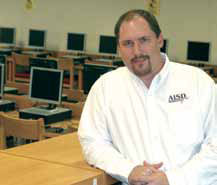CIO Profile: Kyle Berger

Name : Kyle Berger
Age : 33
Title : Executive director of technology, since 2004
District : Alvarado (TX) Independent School District
Tell us some of your big-picture tech goals for the year.
One is an advancement in technology interface with special-needs children. I feel that within the coming months, what we are able to do with this technology will be exciting news for others to use in their districts. We are developing applications to push content to students and stakeholders where they are, 24/7, mainly in the mobile platforms preparing us for BYOD [bring your own device].
More advancements in virtualdesktop environment will allow us to expand the lifelines of district devices but also prepare us for the BYOD evolution.
Tools and ideas to transform education. Sign up below.
We want to make our district more data driven and be able to present needed data in simple forms to all parties involved.
Which tech accomplishment are you most proud of?
The one-to-one movement in grades four through eight is one that I am proud of, because it shows that the district values technology in the classroom and because so many people came together to make it happen. Our community-outreach program providing free Internet access is another one that I enjoy, because it turned out to be a completely self-funded initiative that has reached out to our community to provide needed access. On the technical side, I am proud of our award-winning disaster-recovery initiative, which connects schools across the country with disaster-recovery ability free, and our streamlined automated business process, which makes overall user and program management a nonissue because of advanced identity management and provisioning.
Are you planning to let students BYOD? If so, when?
We are looking at the BYOD game plan for our district. With us already having a large one-to-one deployment in grades four through eight, the need for one-toone computing at other levels is apparent. Our overall thinking is that we standardize on district-owned devices in the lower grades (possibly up to eighth grade); at that point we want to let the technology become more personal to the user but also beneficial in the education as well. So BYOD is targeted to our high school students. We are looking at pilot rollouts within the next nine months for phase one.
Several factors have led to a slower adoption of BYOD for our district. One is the potential classroom difficulty with a mixed population of devices to teach to and the impact on instruction. Mainly we want to ensure that the tools are not a distraction in our educational environment. A have-and-have-not situation among our students is also a factor. The main thing driving us to this is, of course, funding, as we are being hit with dramatic decreases each year.
Traditional or online textbooks?
Our district already has a large collection of e-books. We are moving toward more textbooks online, as we have found the content to be better and more appealing to our students. I believe that no matter what advancements take place, there will always still be some need for traditional books in education. We still have traditional books in our library.
Can your students and/or teachers use Facebook, MySpace, and similar Web 2.0 tools?
At this point, Facebook and MySpace are limited internally for students. We are constantly evaluating these tools but moving a bit slower on those sites because of an increase in cyberbullying. However, the district and campus locations do have a presence on Facebook and use it often to communicate. Besides these two sites, we are open to other Web 2.0 tools, like blogging and podcasting, for students and teachers.
Professional development: face-toface, online, or blended?
In my opinion, blended is the key. The need in some instances for face-to-face is apparent, but online is valuable for just-in-time learning and refresher-based learning for end users and professionals.
What are some of your guilty pleasures?
I work too much!
